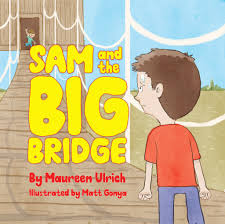Sam and the Big Bridge

Sam and the Big Bridge
Sam was anxious.
When Mom took Sam and his brother to the park across the street, Sam warned Derek not to pump too high on the swing or hang by his knees from the monkey bars.
On the picture book’s opening page, Sam describes three scenarios, the excerpt being one, in which Sam had expressed concern about the safety of his younger brother, Derek. These statements could lead young readers/listeners to think, “My, what a wonderful older brother, one who obviously cares about the well-being of his sibling.” However, Sam’s words can also be read as being not other directed but, instead, as an admission of his own emotional self-assessment.
And such an interpretation is the case, as readers can see, when Sam accompanies Derek to Ninja camp, an event that is occurring at a playground that has, according to Mom, “very big equipment.” Mom, recognizing her older son’s emotional makeup, including his fear of the new and unknown, had initially not registered Sam for the camp, only doing so upon his insistence. On the brothers’ first day at camp, Sam balks at going down a tunnel slide, abandons the ascending stumps after just climbing on the first one, and has such a tearful meltdown on the rope bridge that he has to be rescued by Mom who attempts to comfort him by saying, “It’s okay, Sam. You can’t do everything you want the first time.” Meanwhile, as can be observed in the background of one of Gonya’s cartoon-style illustrations, Derek appears to be having great fun on the playground’s equipment.
After a largely sleepless night during which Sam relived the previous day’s events, he faces the new day by saying, “I want to go back to the big playground.” After Mom affirms, “Are you sure?”, they are off to the playground where Sam immediately heads to yesterday’s biggest “failure”, the rope bridge, which he gingerly conquers before returning to the ascending stumps (“He didn’t make it to the higher ones, but he’d gone farther than the day before.”) and then “whoosh[ing] feet first down the slide.”
Ulrich’s story accurately mirrors what happens in many playgrounds as children encounter new pieces of equipment for the very first time, with some finding themselves, at that moment, unwilling to take on the challenges being presented to them. And would all such children have understanding and supportive parents like Sam’s mother who, when he successfully finished playing on the three pieces of equipment that he had abandoned the previous day, said: “Sam, I’m proud of you...but I’d be proud of you even if you’d decided you didn’t want to do any of this.”
Sam and the Big Bridge would make a good home purchase, especially for those families that recognize they have a “Sam”. However, as a picture book, it’s a little too wordy on some pages, a situation that then challenges Gonya in creating illustrations that will sustain nonreading listeners’ attention while the adult delivers the longer text. In the “failed” rope bridge illustration, Gonya needed to make Mom a bit larger to make it clear that the running figure in the background (which can be identified as “rescuing” Mom via the colour of her clothes) is not just another ponytailed playground child like the girl in the foreground. And finally, the book’s binding is two staples, and my centre sheet separated from the book.
Dave Jenkinson, CM’s editor, lives in Winnipeg, Manitoba, where he’s still anxious when faced with accompanying grandchildren on some amusement park rides.
